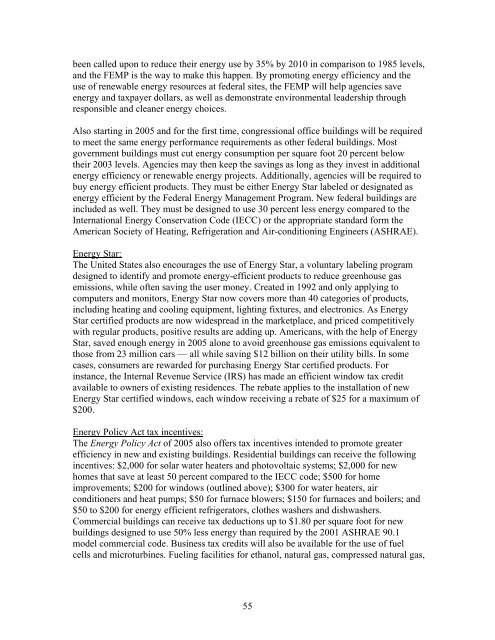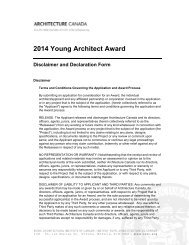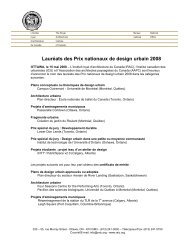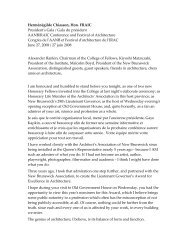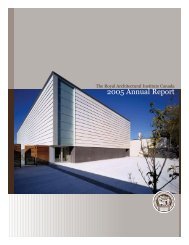Benchmark Study on Green Buildings - Royal Architectural Institute ...
Benchmark Study on Green Buildings - Royal Architectural Institute ...
Benchmark Study on Green Buildings - Royal Architectural Institute ...
You also want an ePaper? Increase the reach of your titles
YUMPU automatically turns print PDFs into web optimized ePapers that Google loves.
een called up<strong>on</strong> to reduce their energy use by 35% by 2010 in comparis<strong>on</strong> to 1985 levels,<br />
and the FEMP is the way to make this happen. By promoting energy efficiency and the<br />
use of renewable energy resources at federal sites, the FEMP will help agencies save<br />
energy and taxpayer dollars, as well as dem<strong>on</strong>strate envir<strong>on</strong>mental leadership through<br />
resp<strong>on</strong>sible and cleaner energy choices.<br />
Also starting in 2005 and for the first time, c<strong>on</strong>gressi<strong>on</strong>al office buildings will be required<br />
to meet the same energy performance requirements as other federal buildings. Most<br />
government buildings must cut energy c<strong>on</strong>sumpti<strong>on</strong> per square foot 20 percent below<br />
their 2003 levels. Agencies may then keep the savings as l<strong>on</strong>g as they invest in additi<strong>on</strong>al<br />
energy efficiency or renewable energy projects. Additi<strong>on</strong>ally, agencies will be required to<br />
buy energy efficient products. They must be either Energy Star labeled or designated as<br />
energy efficient by the Federal Energy Management Program. New federal buildings are<br />
included as well. They must be designed to use 30 percent less energy compared to the<br />
Internati<strong>on</strong>al Energy C<strong>on</strong>servati<strong>on</strong> Code (IECC) or the appropriate standard form the<br />
American Society of Heating, Refrigerati<strong>on</strong> and Air-c<strong>on</strong>diti<strong>on</strong>ing Engineers (ASHRAE).<br />
Energy Star:<br />
The United States also encourages the use of Energy Star, a voluntary labeling program<br />
designed to identify and promote energy-efficient products to reduce greenhouse gas<br />
emissi<strong>on</strong>s, while often saving the user m<strong>on</strong>ey. Created in 1992 and <strong>on</strong>ly applying to<br />
computers and m<strong>on</strong>itors, Energy Star now covers more than 40 categories of products,<br />
including heating and cooling equipment, lighting fixtures, and electr<strong>on</strong>ics. As Energy<br />
Star certified products are now widespread in the marketplace, and priced competitively<br />
with regular products, positive results are adding up. Americans, with the help of Energy<br />
Star, saved enough energy in 2005 al<strong>on</strong>e to avoid greenhouse gas emissi<strong>on</strong>s equivalent to<br />
those from 23 milli<strong>on</strong> cars — all while saving $12 billi<strong>on</strong> <strong>on</strong> their utility bills. In some<br />
cases, c<strong>on</strong>sumers are rewarded for purchasing Energy Star certified products. For<br />
instance, the Internal Revenue Service (IRS) has made an efficient window tax credit<br />
available to owners of existing residences. The rebate applies to the installati<strong>on</strong> of new<br />
Energy Star certified windows, each window receiving a rebate of $25 for a maximum of<br />
$200.<br />
Energy Policy Act tax incentives:<br />
The Energy Policy Act of 2005 also offers tax incentives intended to promote greater<br />
efficiency in new and existing buildings. Residential buildings can receive the following<br />
incentives: $2,000 for solar water heaters and photovoltaic systems; $2,000 for new<br />
homes that save at least 50 percent compared to the IECC code; $500 for home<br />
improvements; $200 for windows (outlined above); $300 for water heaters, air<br />
c<strong>on</strong>diti<strong>on</strong>ers and heat pumps; $50 for furnace blowers; $150 for furnaces and boilers; and<br />
$50 to $200 for energy efficient refrigerators, clothes washers and dishwashers.<br />
Commercial buildings can receive tax deducti<strong>on</strong>s up to $1.80 per square foot for new<br />
buildings designed to use 50% less energy than required by the 2001 ASHRAE 90.1<br />
model commercial code. Business tax credits will also be available for the use of fuel<br />
cells and microturbines. Fueling facilities for ethanol, natural gas, compressed natural gas,<br />
55


